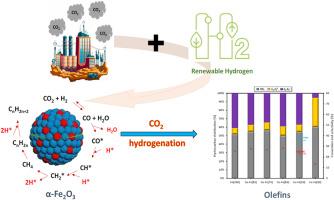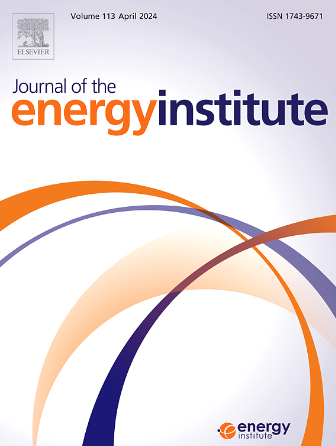铜掺入对选择性二氧化碳加氢制烯烃的铁基催化剂的影响
IF 5.6
2区 工程技术
Q2 ENERGY & FUELS
引用次数: 0
摘要
通过与可再生氢气反应将二氧化碳转化为可持续化学原料和燃料的过程一直被视为能源研究中一个前景广阔的方向。在铁催化剂上通过铜改性提高 CO2 加氢效率以生产有价值的碳氢化合物(特别是烯烃)已得到广泛研究。然而,关于这些改性对催化特性的影响及其内在机理的争论仍在继续。与用于 CO2 加氢的未催化铁基催化剂相比,C2-C4 和 C5+ 等所需产物的选择相对较少。因此,经常使用促进剂来定制和增强产物分布。本研究探讨了在铁基支撑催化剂中添加 Cu 如何影响其将 CO2 转化为碳氢化合物的性能,并特别强调了铁和 Cu 之间的相互作用。为实现这一目标,研究人员采用共沉淀方法制造催化剂,并改变其中铁和铜的分布。在 350 °C 和 30 bar 压力下,使用反应物气体混合物在固定床装置中对一组复合催化剂进行了测试。XRD、SEM、TEM、NH3-TPD、H2-TPR 和 N2 吸附-解吸等温线等分析技术显示,复合催化剂中存在铁-铜相互作用。这两种成分之间的相互作用协同增强了二氧化碳加氢的催化活性。本文章由计算机程序翻译,如有差异,请以英文原文为准。

Effect of Cu incorporation on Fe-based catalysts for selective CO2 hydrogenation to olefins
The process of converting CO2 into sustainable chemical feedstock and fuels through reaction with renewable hydrogen has been regarded as a promising direction in energy research. The enhancement of CO2 hydrogenation efficiency to produce valuable hydrocarbons (specifically olefins) on Fe catalysts through Cu modification has been extensively researched. However, there is ongoing vigorous debate regarding the impact of these modifications on catalytic properties and the underlying mechanism. When compared to unprompted iron-based catalysts for CO2 hydrogenation, the choice of desired products, such as C2-C4 and C5+, is relatively low. So, promoters are frequently employed to customize and enhance product distribution. This study investigates how adding Cu to Fe-based supported catalysts affects their performance in converting CO2 to hydrocarbons, with a specific emphasis on the interaction between Fe and Cu. To achieve this goal, catalysts were created using co-precipitation methods, varying the distribution of Fe and Cu within them. A set of composite catalysts underwent testing in a fixed bed setup using a reactant gas mixture at 350 °C and 30 bar pressure. Analysis techniques such as XRD, SEM, TEM, NH3-TPD, H2-TPR, and N2 adsorption-desorption isotherms revealed the presence of iron-copper interaction within the composite catalysts. This interaction between the two components synergistically enhances the catalytic activity in CO2 hydrogenation.
求助全文
通过发布文献求助,成功后即可免费获取论文全文。
去求助
来源期刊

Journal of The Energy Institute
工程技术-能源与燃料
CiteScore
10.60
自引率
5.30%
发文量
166
审稿时长
16 days
期刊介绍:
The Journal of the Energy Institute provides peer reviewed coverage of original high quality research on energy, engineering and technology.The coverage is broad and the main areas of interest include:
Combustion engineering and associated technologies; process heating; power generation; engines and propulsion; emissions and environmental pollution control; clean coal technologies; carbon abatement technologies
Emissions and environmental pollution control; safety and hazards;
Clean coal technologies; carbon abatement technologies, including carbon capture and storage, CCS;
Petroleum engineering and fuel quality, including storage and transport
Alternative energy sources; biomass utilisation and biomass conversion technologies; energy from waste, incineration and recycling
Energy conversion, energy recovery and energy efficiency; space heating, fuel cells, heat pumps and cooling systems
Energy storage
The journal''s coverage reflects changes in energy technology that result from the transition to more efficient energy production and end use together with reduced carbon emission.
 求助内容:
求助内容: 应助结果提醒方式:
应助结果提醒方式:


